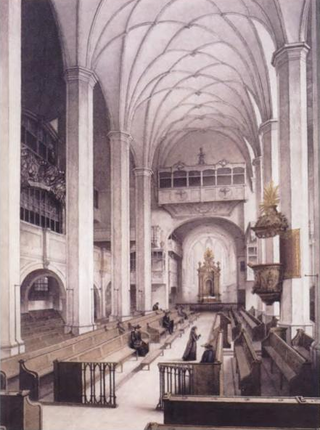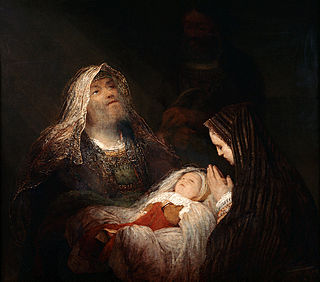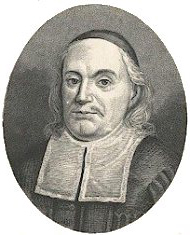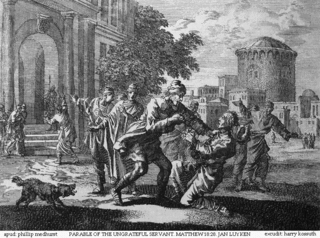
Johann Sebastian Bach composed Vergnügte Ruh, beliebte Seelenlust, BWV 170, a church cantata for the sixth Sunday after Trinity in Leipzig. It is a solo cantata for alto that he first performed on 28 July 1726.

Johann Sebastian Bach composed the church cantata Gott soll allein mein Herze haben, BWV 169, a solo cantata for an alto soloist, in Leipzig for the 18th Sunday after Trinity, and first performed it on 20 October 1726.

Johann Sebastian Bach composed the church cantata Mein Herze schwimmt im BlutBWV 199 in Weimar between 1712 and 1713, and performed it on the eleventh Sunday after Trinity, 12 August 1714. It is a solo cantata for soprano.

Johann Sebastian Bach composed the church cantata Wo soll ich fliehen hin, BWV 5, in Leipzig for the 19th Sunday after Trinity and first performed it on 15 October 1724. The chorale cantata is based on the hymn "Wo soll ich fliehen hin" by Johann Heermann.

Johann Sebastian Bach composed the church cantata Jauchzet Gott in allen LandenBWV 51, in Leipzig. The work is Bach's only church cantata scored for a solo soprano and trumpet. He composed it for general use, in other words not for a particular date in the church calendar, although he used it for the 15th Sunday after Trinity: the first known performance was on 17 September 1730 in Leipzig. The work may have been composed earlier, possibly for an occasion at the court of Christian, Duke of Saxe-Weissenfels, for whom Bach had composed the Hunting Cantata and the Shepherd Cantata.

Johann Sebastian Bach composed the church cantata Herz und Mund und Tat und Leben, BWV 147 in 1723 during his first year as Thomaskantor, the director of church music in Leipzig. His cantata is part of his first cantata cycle there and was written for the Marian feast of the Visitation on 2 July, which commemorates Mary's visit to Elizabeth as narrated in the Gospel of Luke in the prescribed reading for the feast day. Bach based the music on his earlier cantata BWV 147a, written originally in Weimar in 1716 for Advent. He expanded the Advent cantata in six movements to ten movements in two parts in the new work. While the text of the Advent cantata was written by the Weimar court poet Salomo Franck, the librettist of the adapted version who added several recitatives is anonymous.

Ich will den Kreuzstab gerne tragen, BWV 56, is a church cantata composed by Johann Sebastian Bach for the 19th Sunday after Trinity. It was first performed in Leipzig on 27 October 1726. The composition is a solo cantata because, apart from the closing chorale, it requires only a single vocal soloist. The autograph score is one of a few cases where Bach referred to one of his compositions as a cantata. In English, the work is commonly referred to as the Kreuzstab cantata. Bach composed the cantata in his fourth year as Thomaskantor; it is regarded as part of his third cantata cycle.
Der Friede sei mit dir, BWV 158, is one of the shortest of the cantatas by Johann Sebastian Bach and features a bass soloist. It survives as a cantata for the third day of Easter but might be a fragment of a work originally written for Purification. Given this background, and the fact that it was copied by Christian Friedrich Penzel, one of Bach's last students, there is a confusing variety of proposed composition dates. It may date back to Bach's Weimar period, although a date as late as 1735 has been suggested.

Sie werden euch in den Bann tun, BWV 44, is a church cantata by Johann Sebastian Bach. He composed it in Leipzig for Exaudi, the Sunday after Ascension, and first performed it on 21 May 1724. It is part of his first cantata cycle.
Mer hahn en neue Oberkeet, BWV 212, is a secular cantata by Johann Sebastian Bach. It was entitled the "Cantate burlesque" by Bach himself, but is now popularly known as the Peasant Cantata. It is the last definitely dated Bach cantata.

Johann Sebastian Bach composed the church cantata Ach! ich sehe, itzt, da ich zur Hochzeit gehe, BWV 162, in Weimar for the 20th Sunday after Trinity and first performed it in 1715 or 1716.

Erfreute Zeit im neuen Bunde, BWV 83, is a church cantata by Johann Sebastian Bach. He wrote it in 1724 in Leipzig for the feast Mariae Reinigung (Purification) and first performed it on 2 February 1724.

Ich hab in Gottes Herz und Sinn, BWV 92, is a cantata by Johann Sebastian Bach for use in the Lutheran service. He composed the chorale cantata in Leipzig for Septuagesimae and first performed it on 28 January 1725. It is based on the hymn "Ich hab in Gottes Herz und Sinn" by Paul Gerhardt (1647), and is the only chorale cantata Bach based on a hymn by Gerhardt.

Johann Sebastian Bach composed the church cantata Was soll ich aus dir machen, Ephraim, BWV 89, in Leipzig for the 22nd Sunday after Trinity and first performed it on 24 October 1723.

Ich bin ein guter Hirt, BWV 85, is a church cantata by Johann Sebastian Bach. He composed it in Leipzig for the second Sunday after Easter and first performed it on 15 April 1725.

Bisher habt ihr nichts gebeten in meinem Namen, BWV 87, is a church cantata by Johann Sebastian Bach. He composed it in Leipzig for Rogate, the fifth Sunday after Easter, and first performed it on 6 May 1725.

Wo Gott der Herr nicht bei uns hält, BWV 178 is a church cantata by Johann Sebastian Bach. He composed it in Leipzig for the eighth Sunday after Trinity and first performed it on 30 July 1724. It is a chorale cantata from his second annual cycle, based on the hymn "Wo Gott der Herr nicht bei uns hält" (1524) by Justus Jonas, a paraphrase of Psalm 124.
Ich habe meine Zuversicht, BWV 188, is a church cantata by Johann Sebastian Bach. He composed the cantata in Leipzig for the 21st Sunday after Trinity and probably first performed it on 17 October 1728.
Weichet nur, betrübte Schatten, BWV 202, is a secular cantata by Johann Sebastian Bach. It was likely composed for a wedding, but scholars disagree on the dating which could be as early as Bach's tenure in Weimar, around 1714, while it has traditionally been connected to his wedding to Anna Magdalena on 3 December 1721 in Köthen. It is one of Bach's frequently recorded cantatas. The aria "Sich üben im Lieben" is often performed as a concert piece.
This is a list of recordings of Bach's cantata Ich will den Kreuzstab gerne tragen, BWV 56, a solo cantata for bass or bass-baritone composed for the 19th Sunday after Trinity, first performed on 29 October 1726. In English, it is commonly referred to as the Kreuzstab cantata.













